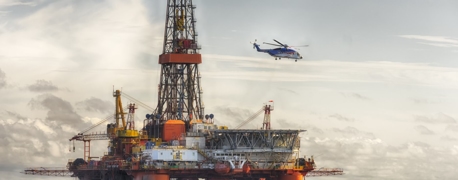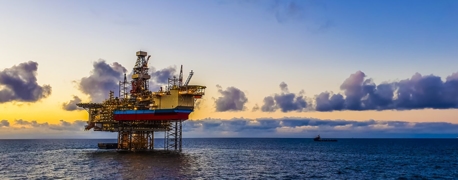The World’s Most Dangerous Maritime Shipping Routes

Over thousands of years, maritime routes have acted as conduits for trade as well as exploration, cultural exchange, and even conflict. Navigating these waters is a high-stakes undertaking where the forces of nature clash with the ambitions of commerce and the complexities of international politics.
At sea, the stakes are monumental, involving not just valuable cargo but mariners’ lives.
From the pirate-infested waters of the Gulf of Aden to the storm-ridden North Sea, each region presents its unique set of perils. Here, we will consider the world's most hazardous maritime routes, exposing the factors that make them dangerous—and who is ultimately responsible for protecting the well-being of the men and women on the vessels and rigs that brave them.
Gulf of Mexico, Bay of Campeche
The Gulf of Mexico, particularly the Bay of Campeche, is a region of immense importance and inherent risks, primarily linked to the oil and gas industry. Situated along the southern coast of the United States and the eastern coast of Mexico, the Gulf of Mexico is a critical hub for energy production, featuring major players such as Shell, BP, Chevron, and Exxon Mobil. The Bay of Campeche is known for its dense concentration of Mexican offshore oil rigs.
The importance of this region to the global oil and gas industry cannot be overstated. However, the Gulf of Mexico faces significant threats that pose risks to maritime commerce and offshore operations. One of the most prominent dangers is the extreme weather conditions prevalent in the area, particularly hurricanes. These severe weather events can cause substantial disruptions to oil and gas activities, endangering both infrastructure and personnel.
In addition to natural threats, the Gulf of Mexico is also affected by illegal activities, notably fuel trafficking by Mexican cartels. In March 2023, local reports indicated that there were as many as 6 robberies in the Bay of Campeche.
Maritime Area Between Venezuela & Guyana
The maritime area between Venezuela and Guyana, off the northern coast of South America, holds significant importance due to the rich oil and mineral resources in the Essequibo region and its offshore areas. This region has become a focal point of tension between the two countries, each vying for control over its valuable resources, especially following major offshore crude and gas discoveries.
Maritime security in this region has been a concern, as highlighted by ICC International Maritime Bureau statistics. From 2018 to 2022, South America's coastline experienced various maritime incidents. While most nations reported low levels of pirate attacks, Venezuela experienced a spike with 11 incidents in 2018, emphasizing the security challenges in the maritime area between Venezuela and Guyana. Although this trend has tapered off in subsequent years, it remains a reminder of the ongoing need for caution in this geopolitically sensitive and resource-rich maritime zone.
The Red Sea & The Gulf of Aden
Spanning the waters between Africa and Asia, the Red Sea and the Gulf of Aden form a crucial maritime corridor with considerable historical, ecological, and economic significance.
The Red Sea, known for its vibrant coral reefs and rich marine life, stretches from the Suez Canal in the north to the Bab el-Mandeb Strait at its southern end. It serves as a critical link between the Mediterranean Sea and the Indian Ocean. Parallel to this, the Gulf of Aden, lying between Yemen on the Arabian Peninsula and Somalia in East Africa, connects the Red Sea to the Arabian Sea. This location marks the Gulf of Aden as an essential passage for global maritime traffic, particularly for ships navigating to and from the Indian Ocean and the Mediterranean.
This region has become increasingly volatile due to attacks on ships off the Yemeni coast by Houthi rebels, particularly targeting oil transportation. These assaults have paralyzed a key maritime route, disrupting the flow of goods between Asia and Europe. The Red Sea is usually bustling with shipping traffic. However, the intensifying militant activity has forced many major shipping companies to suspend their usual routes through this area. Instead, ships are being rerouted around southern Africa, a significantly slower and more costly alternative.
Over 2,000 ships have been redirected since the initial Houthi attack on November 19. 2023. This diversion not only affects shipping schedules but also adds substantial financial burdens to global trade operations. In response to these growing threats, the U.K. and U.S. have recently conducted military strikes against numerous rebel sites in Yemen, further escalating the already high regional tensions, particularly in light of the ongoing conflict in Gaza.
This combination of military conflict and piracy has transformed the Red Sea and the Gulf of Aden into some of the most perilous waters for maritime navigation and commerce.
The South China Sea & East Indies
The South China Sea and East Indies region, encompassing a vast expanse of the Pacific Ocean, is a critical yet contentious maritime zone. The South China Sea, in particular, is a hotspot for overlapping sovereignty claims involving several nations: China, the Philippines, Brunei, Malaysia, Taiwan, and Vietnam. These disputes stem from the region's strategic and economic significance, as it is a major conduit for global trade, with over $3 trillion worth of goods passing through annually.
Heavy maritime traffic and complex territorial disputes often lead to tensions among the claimant states, creating an environment of uncertainty and risk. The presence of valuable resources, like fish stocks and potential oil and gas reserves, further intensifies these conflicts. Moreover, the region's waters are occasionally plagued by piracy, adding another layer of danger to the already volatile mix.
The ecological significance of this region cannot be overstated, especially as it includes the Coral Triangle, known for its incredible marine biodiversity. This area is home to 76% of the world's coral species and a rich array of marine life. However, the environmental well-being of the area is constantly threatened by the high number of shipping accidents, with 293 incidents recorded since 1999. These accidents disrupt maritime activities, pose a significant threat to the delicate marine ecosystems, and jeopardize the well-being of crew members and passengers on the affected vessels.
Northern Black Sea
The Northern Black Sea, adjacent to Ukraine, has long been an essential maritime trade corridor, rich in biodiversity and fisheries, and a crossroads of diverse cultures. Historically, it has been a dynamic center for economic and social exchange. However, recent events have drastically altered its character.
The conflict between Russia and Ukraine has notably shifted the landscape of the Northern Black Sea. What was once a thriving route for commerce is now a region marked by danger and conflict. The Russian invasion has escalated tensions, leading to naval standoffs and strategic disputes, elevating the risks for maritime activities. This escalation has disrupted the safety of commercial shipping and introduced a new level of uncertainty and instability in the region.
Gulf of Guinea
The Gulf of Guinea, located off the West Coast of Africa, has garnered a notorious reputation as one of the most perilous regions for maritime activities worldwide. This area is particularly infamous for its high levels of piracy and armed robbery at sea, posing a significant threat to the safety and security of international shipping.
The International Maritime Bureau (IMB) reported at least 9 pirate attacks in 2023 alone.
The Strait of Malacca
The Strait of Malacca, a narrow passage between the Malay Peninsula and the Indonesian island of Sumatra, is a pivotal artery in global maritime trade. Recognized as one of the world's most heavily trafficked shipping lanes, it serves as a crucial transit point for commercial vessels and oil tankers en route to the Middle East, East Asia, and Japanese ports. This strait's importance stems from its role as a strategic link between the Indian Ocean and the Pacific Ocean.
The very factors that make the Strait of Malacca essential also contribute to its reputation as a dangerous passage. The strait's narrowness leads to congested waters, heightening the risk of maritime accidents. Additionally, the region has historically been troubled by piracy and armed robberies, posing serious threats to the safety of vessels and their crews. In 2021, the Strait of Malacca recorded the highest number of reported acts of alleged piracy and robberies in Asia.
While efforts by surrounding nations—Indonesia, Malaysia, Thailand, and Singapore—to conduct coordinated patrols and improve vessel security have led to a notable decrease in piracy incidents, the danger has not been completely eradicated. For instance, as recently as October 2023, an attack on a bulk carrier in the strait resulted in the injury of a crew member.
Singapore Strait
The Singapore Strait, a narrow corridor just 70 miles long and 12 miles wide, serves as an important juncture between the Strait of Malacca in the west and the South China Sea in the east. This strait is of paramount importance for global maritime trade, facilitating a constant flow of vessels through one of the most congested and strategically significant waterways in the world.
However, the significance of the Singapore Strait in international shipping is paralleled by the risks it presents. The strait has been a focus of concern due to the prevalence of maritime incidents, many of which are categorized as low-level opportunistic crimes. Despite their seemingly minor nature, these incidents occur with alarming frequency and a high rate of success. In recent years, there has been a noticeable increase in such activities. For instance, the number of incidents in the Singapore Strait rose dramatically from just 3 in 2018 to 38 in 2022. This surge suggests a shifting pattern of pirate activity in Southeast Asia, positioning the Singapore Strait as a new focal point of concern.
While piracy in the neighboring straits, like the Strait of Malacca, has seen a decrease, the Singapore Strait continues to grapple with safety challenges. In 2023, the strait witnessed 37 reported incidents, a slight decrease from the previous year but still remarkably high. This rate of success in reported incidents, standing at 95%, shows just how persistent the threat is in these waters.
North Sea & British Isles
The North Sea and the waters around the British Isles are critical yet challenging for maritime activities. Characterized by unpredictable weather, including frequent storms and strong winds, navigation in this region is particularly treacherous.
The worst maritime disaster in the North Sea is widely considered to be the capsizing of the Alexander L. Kielland, a Norwegian semi-submersible drilling rig, on March 27, 1980. The disaster occurred in the Ekofisk oil field off the coast of Norway. During a sudden storm, one of the rig's five anchor cables snapped, causing a crack in one of its legs. This eventually led to the rig capsizing.
Of the 212 people on board, 123 lost their lives, making it one of the deadliest offshore oil rig accidents in history.
The inherent dangers of the North Sea are further heightened by its status as one of the busiest maritime routes. The dense traffic in these waters significantly increases the likelihood of collisions and accidents. What’s more, the North Sea's extensive oil and gas operations introduce additional operational complexities and environmental risks. When combined with the challenging navigation dictated by its intricate geography, these elements collectively render the North Sea and British Isles among the most hazardous areas for maritime activities.
Gulf of Oman
The Gulf of Oman, situated between Oman and Iran, is a key maritime zone connecting the Arabian Sea with the Strait of Hormuz. Its strategic position makes it vital for international shipping, particularly for oil tankers from the Persian Gulf. However, this importance also renders it a region fraught with dangers.
A recent incident highlighting the risks in this region involved the seizure of the Marshall Islands-flagged tanker, St Nikolas, by Iranian forces. In January, the tanker, carrying Iraqi crude destined for Turkey, was intercepted and directed toward Iranian territorial waters. This act was reportedly in retaliation for a previous seizure of the same vessel by the U.S. in a sanctions enforcement operation. Such incidents in the Gulf of Oman not only escalate regional tensions but also pose significant risks to maritime security and commercial shipping operations.
The Gulf of Oman’s proximity to conflict areas, including Yemen and Iran, adds to its volatility. Military confrontations and proxy conflicts in the region frequently disrupt shipping lanes and endanger vessels. Moreover, the Gulf's location near the Strait of Hormuz, a crucial oil bottleneck, makes it a focal point for political and military actions, further escalating the risks for maritime operations in these waters.
Other Hazardous Routes
- Atlantic Ocean off the Spanish Coast: The Prestige oil tanker disaster in 2002 highlights the environmental risk in this region. With changing climate patterns and the potential for extreme weather, the risk of accidents in the Atlantic, particularly involving oil tankers, remains a concern.
- The North Atlantic Ocean: This route, particularly around the Bermuda Triangle and the North Sea, is known for its unpredictable weather, including heavy storms and icy conditions, making navigation challenging.
- The Cape of Good Hope (South Africa): Ships often face rough seas, high winds, and strong currents here. This route is used as an alternative to the Suez Canal, but its challenging conditions make it risky.
- The Arctic Routes: With the melting ice caps, these routes are becoming more navigable but remain extremely dangerous due to icebergs, freezing temperatures, and remote locations, which make rescue operations difficult.
- The Bering Strait: Between Russia and Alaska, this strait is treacherous due to icy waters, strong currents, and the presence of icebergs.
- The Cook Strait (New Zealand): Known for its rough waters, strong currents, and unpredictable weather, making it a challenging route for ships.
Ensuring Safety in Perilous Waters: Who Is Ultimately Responsible?
In the complex and often hazardous world of maritime navigation, the responsibility of safeguarding crews squarely falls on the shoulders of maritime employers. This responsibility extends across a broad spectrum of entities, including shipping companies, oil and gas conglomerates, shipowners, and operators of vessels and rigs. These parties bear the critical duty of not only ensuring the safety and well-being of their crews but also protecting the environment.
At the heart of this responsibility is a commitment to proactive and preventative measures. Employers must prioritize the safety of their crew above all else, whether that means rerouting vessels to circumvent areas known for piracy, ensuring rigorous and regular vessel maintenance, or adopting strategies for storm avoidance and navigation through treacherous waters. The significance of these actions cannot be overstated, as they are essential for minimizing risks in environments where the margin for error is often slim.
The mandate for these maritime employers is clear: crew safety is paramount, and there are no acceptable excuses or exceptions. No matter what.


